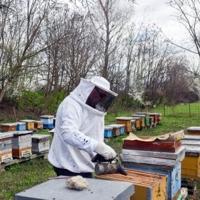Magda Miloseska wears a white, protective suit every day as she tends to the honeybees in her backyard in North Macedonia. For over 20 years, she has been producing honey in this scenic part of the country. However, the challenges posed by climate change and diseases have made this once simple pleasure much more difficult, according to her.
Stence, situated in the western part of the country, is a hillside village surrounded by mountains at an elevation of 650 metres (2,130 feet). The temperatures in June have already exceeded 30 degrees Celsius (86 Fahrenheit), which is three degrees higher than usual, as reported by the state meteorological office.
“Beekeeping used to be much simpler in the past,” said 63-year-old Miloseska. “It was a joy to engage in beekeeping.”
“Today, we are forced to battle against the challenging climate conditions and diseases that have affected beekeeping,” she added.
While beekeeping is a hobby for some, it serves as a source of income for others, leading to a surge in beekeeping activities across all regions of the country. In 2023, there were 6,900 registered beekeepers with 306,000 beehives in North Macedonia, according to the Food and Veterinary Agency.
However, a study by the European Commission in July 2023 revealed that 10 percent of bees and butterflies are at risk of extinction in Europe, primarily due to human activities.
– Decrease in Honey Production –
Although Miloseska doesn’t have specific data readily available, her firsthand experience indicates that something is amiss.
“Veteran beekeepers recall being able to harvest 30-50 kilograms (44-66 pounds) of honey from a single beehive in the past,” she shared.
“With the current climate conditions, honey production has significantly declined,” she noted.
Under ideal conditions today, one could expect around 30 kilograms of honey in a season, with average production ranging between 10 and 20 kilograms, she explained.
This scarcity has led to an increase in prices, reaching between 15 and 20 euros ($16-22) compared to 10 euros just a few years ago.
Vladimir Petroski, who has been caring for 120 beehives in his spare time for the past 13 years, has also observed this decline in honey production.
While they used to harvest 30-40 kilograms in the past, nowadays, they are content with 15 kilograms per season, Petroski mentioned.
He agreed that climate change has contributed to the proliferation of parasites and viruses that threaten both wild and honey bees.
“Beekeepers need to educate themselves and adapt to the conditions and micro-climate where they operate,” he emphasized.
– Education and Adaptation –
Beekeepers are actively seeking solutions to these challenges.
Regional beekeepers’ associations are collaborating to promote best practices and organize honey festivals.
They identify warm winters, rapid temperature changes in spring, and extended dry periods in summers stretching into September and October as the main obstacles.
Environmental groups are urging government ministries and agencies to work together to address the issues posed by climate change on bees.
However, their concerns have largely been overlooked so far.
The agriculture ministry also recognizes the threats posed by intensive agriculture, pesticides, loss of biodiversity, and pollution.
While acknowledging the risks of climate change, the ministry has advised monitoring bee behavior more closely.
Frosina Pandurska Dramikjanin from the Macedonian Ecological Society, part of a project studying the impact of climate change on bees, stressed the importance of sharing data among relevant state institutions.
“Without this collaboration, it is challenging to formulate measures and recommendations,” she told AFP.
A recent report from the United Nations Environmental Programme underlined the critical role bees play in food production and biodiversity.
Out of the 100 crop species that account for 90 percent of global food consumption, 71 depend on bees for pollination, the report highlighted.
dd/jj





